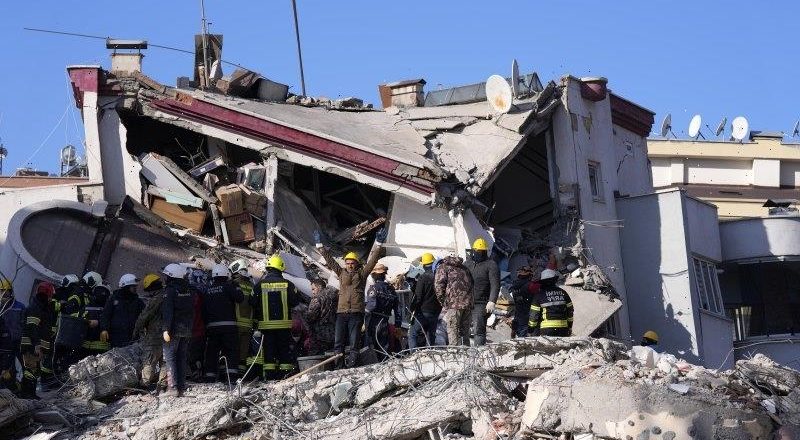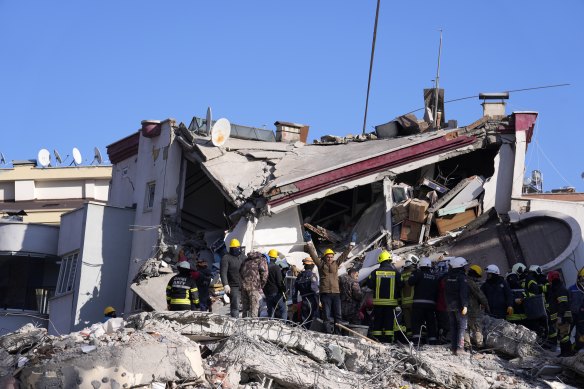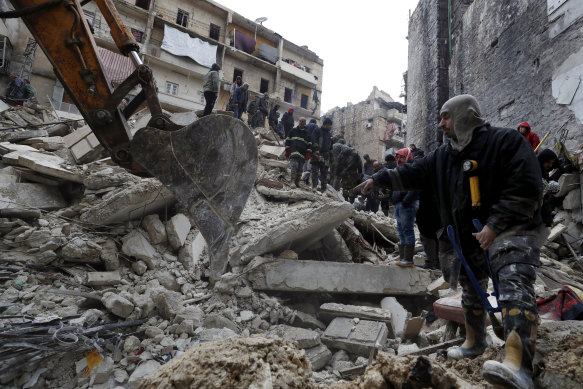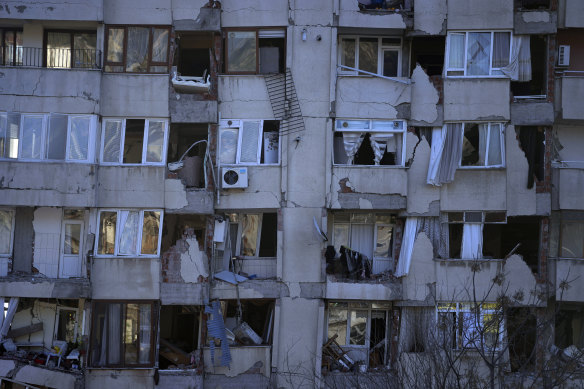Earthquake rescues, require noisy gear, heavy digging, and silence
Adana: They lifted slabs of cement with enormous cranes and smashed rubble with jackhammers. Then, they stopped.
Silence.
It’s key to detecting the faintest noise that could be the sign of a survivor buried beneath rubble from Monday’s quake in Turkey and Syria.
A member of rescue team asking people to be silent for them to hear the people under the debris of a collapsed building, in Ghaziantep, Turkey.Credit:AP
Among the wreckage of a collapsed 14-storey building in the Turkish city of Adana, the shriek of an whistle pierced the noise every few minutes on Wednesday. Rescue workers hollered for quiet, and listened for any hint of voices from the debris. Hundreds of people watching hushed.
During one moment of digging, Volunteer Bekir Bicer uncovered a crushed birdcage, he said. Inside was a blue-and-yellow bird, alive after nearly 60 hours.
“I was very happy. I nearly cried,” Bicer said. “The cage was broken, but the bird was still inside.”
Syrian Civil Defence workers and security forces search through the wreckage of collapsed buildings after a devastating earthquake rocked Syria and Turkey, in Aleppo, Syria.Credit:AP
Friends and family of the trapped sat beside fires, waiting for a miracle even as the survival window for those trapped under the rubble was closing.
Suat Yarkan, 50, said his aunt and her two daughters lived in an apartment on the building’s fourth floor. They would have been home asleep when the quake struck. He was desperate for hope that they could be rescued alive.
“Look at the bird. Sixty hours,” he said. “It makes me feel like maybe God is helping us … I have to believe that they will recover everyone.”
Regular moments of silence are essential to such operations, said David Alexander, professor of emergency planning and management at University College London.
“We often find helicopters chattering overhead, making a huge noise and sometimes also blowing up dust whilst the teams are desperately trying to listen for any kind of noise that might indicate someone alive and moving under the rubble,” he said.
Sophisticated rescue teams will use microphones to pick up faint noises, while specially trained dogs and fibre-optic cameras pick up heat inside mounds of debris. But given the need to move quickly, and the limited number of rescue teams deployed across a huge area, cries for help are key.
“If a person can attract attention under the rubble, their chance of being saved is about three times higher than it would be if they’re in a coma, statistically speaking,” Alexander said.
A destroyed building in Antakya, southern Turkey.Credit:AP
As the sun set Wednesday for the third time on devastated cities and towns in Turkey and Syria, the push to recover survivors became more urgent as the lack of food and water, bitterly cold weather and potential injuries grew even more acute.
Prospects for finding survivors almost three days after the quake are narrow, experts say.
“The first 72 hours are considered to be critical as the condition of people trapped and injured can deteriorate quickly and become fatal if they are not rescued and given medical attention in time,” said Steven Godby, an expert in natural hazards at Nottingham Trent University in England.
In Adana on Wednesday, rescue workers at another collapsed building draped a white sheet across a recess in the mound of debris, obscuring the view of what they’d discovered there.
The digging machines came to a stop, and a stretcher was pulled behind the sheet as the workers looked on in silence.
An ancient city of more than 2 million inhabitants just 32 km from the Mediterranean Sea, Adana has experienced earthquakes before. A 6.3 magnitude tremor in 1998 killed nearly 150 people in the city and its surroundings, and left thousands homeless.
This week’s stronger quake left a large number of Adana’s buildings, many of them modern, seemingly untouched. Many high-rise apartment buildings appeared entirely undamaged. On the city’s northern fringe, however, several 14-story buildings collapsed.
As of Tuesday night, Turkey’s government reported that 167 people had been killed by the earthquake in Adana, with others still trapped beneath the rubble. That was only a tenth of the deaths reported in the devastated Hatay province, miles away.
AP
Get a note directly from our foreign correspondents on what’s making headlines around the world. Sign up for the weekly What in the World newsletter here.
Most Viewed in World
From our partners
Source: Read Full Article




